Let’s Plant Atlantic Wildflowers
Wild Strawberry (Fraisier des champs)
Fragaria virginiana
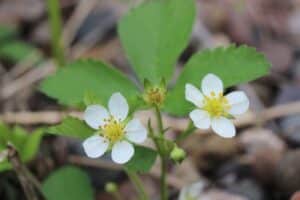
Wild Strawberry photo courtesy of Let’s Plant
How to germinate
Most wild plant seeds have built-in dormancy mechanisms that prevent the seed from germinating. To grow these plants anywhere, you must first break this dormancy mechanism, which will allow the seed to grow. This species has specific germination instructions. It has a germination code of C(60), which means you have to artificially stratify the seeds for 60 days, or sow seeds outdoors in the fall to over-winter naturally to see germination the following spring. Please review the online germination code handbook for more information.
How to plant
Once stratification is complete, sow the seeds outdoors into rows, ¼ inch deep into the soil. Ensure the seeds are spaced 15–25 cm apart.
- This plant needs full or partial sun exposure or complete shade, and medium-wet, medium, medium-dry, or dry soil conditions to grow.
- Can it be chelsea chopped? No
- Can it be aggressive? Yes
Characteristics
- Life cycle: Perennial
- Height: 0.5 feet (15 cm)
- Spread: 1–2 feet (30–60 cm)
- Blooming time: April–June
- Blooming colour: White
- Stratification: Yes
Rose Milkweed (Asclépiade incarnate)
Asclepias incarnata
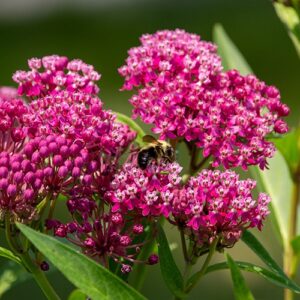
Rose Milkweed photo courtesy of Let’s Plant
How to germinate
Most wild plant seeds have built-in dormancy mechanisms that prevent the seed from germinating. To grow these plants anywhere, you must first break this dormancy mechanism, which will allow the seed to grow. This species has specific germination instructions. It has a germination code of C(30), which means you have to artificially stratify the seeds for 30 days, or sow seeds outdoors in the fall to over-winter naturally to see germination the following spring. Please review the online germination code handbook for more information.
How to plant
Once stratification is complete, sow the seeds outdoors into well-weeded, thin rows, ¼ inch deep into the soil. Ensure the seeds are spaced 45–90 cm apart.
- This plant needs full or partial sun exposure, and wet, medium-wet, or medium soil conditions to grow.
- Can it be chelsea chopped? Yes
- Can it be aggressive? No
Characteristics
- Life cycle: Perennial
- Height: 4–5 feet (120–150 cm)
- Spread: 2–3 feet (60–90 cm)
- Blooming time: June–September
- Blooming colour: Pink
- Stratification: Yes
Sneezeweed (Bois de la toux)
Helenium autumnale
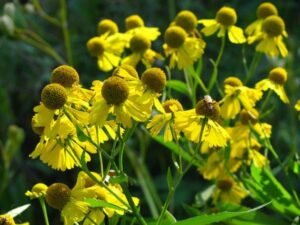
Sneezeweed photo courtesy of Let’s Plant
How to germinate
This species has the germination codes A and D. Please review the online germination code handbook for more information.
How to plant
Direct sow on a weed-free plot, at a depth of ⅛ inches.
- This plant needs full sun exposure or partial shade and wet or medium-wet soil conditions to grow.
- Can it be chelsea chopped? Yes
- Can it be aggressive? No
Characteristics
- Life cycle: Perennial
- Height: 4 feet (120 cm)
- Spread: 2–3 feet (60–90 cm)
- Blooming time: August–October
- Blooming colour: Yellow
- Stratification: None
Calico Aster (Aster latériflore)
Symphyotrichum lateriflorum
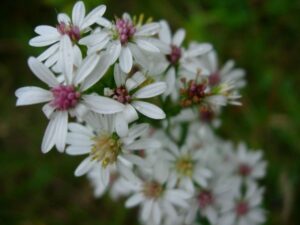
Calico Aster photo courtesy of Let’s Plant
How to germinate
This species has the germination code A, meaning there is no pre-treatment required for the seeds. Please review the online germination code handbook for more information.
How to plant
Outdoor sowing in spring, on a weed-free plot, clear of vegetation is recommended for this plant. Plant seeds spaced 18–36 inches apart.
- This plant needs full, partial sun exposure, or a shaded area in medium-wet, medium, or medium-dry soil.
- Chelsea chopped (a pruning method)? Yes
- Can it be aggressive? Mildly
Characteristics
- Height: 5 feet (150 cm)
- Spread: 2–3 feet (60–90 cm)
- Bloom time: August–October
- Bloom colour: White, purple
- Stratification: None
Wild Bergamot (Monarde Fistuleuse)
Monarda fistulosa
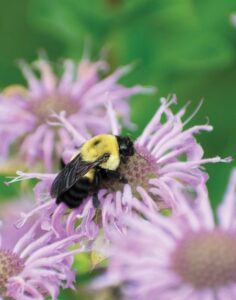
Wild Bergamot photo courtesy of Let’s Plant
How to germinate
This species has the germination code A, meaning no pre-treatment is required for it. Please review the online germination code handbook for more information. For additional planting guidelines, we’ve worked out an estimate on how many seeds you should plant together.
How to plant
Direct sow on weed-free plot at a depth of ⅛ inches.
- This plant needs full or partial sun exposure, and medium-wet, medium, or medium-dry soil conditions to grow.
- Can it be chelsea chopped? Yes
- Can it be aggressive? Somewhat, but can be easily contained.
Characteristics
- Life cycle: Perennial
- Height: 2–4 feet tall (60–120 cm)
- Spread: 2–3 feet wide (60–90 cm)
- Blooming time: July–September
- Blooming colour: Purple
- Stratification: None
Common Evening Primrose (Onagre Bisannuelle)
Oenothera biennis
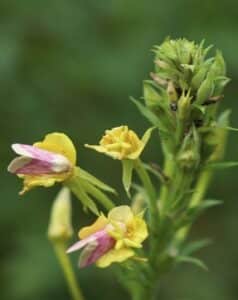
Common Evening Primrose photo courtesy of Let’s Plant
How to germinate
No pre-treatment is required for this species, but the seeds are very small or need light to naturally germinate. This means that the seeds should be surface sown with no soil cover applied, or just a light dusting. This species has the germination codes A, D, and G. Please review the online germination code handbook for more information.
How to plant
Outdoor sowing between late fall and early spring, on a weed-free plot, clear of vegetation is recommended for this plant.
- This plant needs full or partial sun exposure and medium-wet, medium, medium-dry, or dry soil conditions. Rocky or sandy soils are recommended.
- Can it be chelsea chopped? Yes
- Can it be aggressive? Yes
Characteristics
- Life cycle: Perennial
- Height: 6 feet (180 cm)
- Spread: 1–2 feet (30–60 cm)
- Bloom time: June–October
- Bloom colour: Yellow
- Stratification: None
Mountain Mint (Pycnanthème à feuilles étroites)
Pycnanthemum virginianum

Mountain Mint photo courtesy of Let’s Plant
How to germinate
This species has the germination codes A and D. Please review the online germination code handbook for more information.
How to plant
Outdoor surface sowing in spring, on a weed-free plot, clear of vegetation is recommended for this plant species. Place seeds no deeper than ⅛ inch into the soil, making sure they are not completely buried, just lightly covered. Gently water after seeds have been sowed.
- This plant needs full or partial sun exposure and wet, medium-wet, medium, or medium-dry soil conditions to grow.
- Can it be chelsea chopped? Yes
- Can it be aggressive? Yes
Characteristics
- Life cycle: Perennial
- Height: 3 feet (90 cm)
- Spread: 1–1.5 feet (30–45 cm)
- Bloom time: June–September
- Blooming colour: White
- Stratification: None
Early Goldenrod (Verge d’or Jonciforme)
Solidago juncea

Early Goldenrod photo courtesy of Let’s Plant
How to germinate
Most wild plant seeds have built-in dormancy mechanisms that prevent the seed from germinating. To grow these plants anywhere, you must first break this dormancy mechanism, which will allow the seed to grow. This species has specific germination instructions. It has a germination code of C(60), which means you have to artificially stratify the seeds for 60 days, or sow seeds outdoors in the fall to over-winter naturally to see germination the following spring. It also has the germination code D, meaning these seeds are very small and may need light to naturally break the dormancy mechanisms. Please review the online germination code handbook for more information.
How to plant
Once stratification is complete, surface sow the seeds ⅛ inch deep into the soil, ensuring they are only lightly covered with soil.
- This plant needs full or partial sun exposure, and medium, medium-dry, or dry soil conditions to grow.
- Can it be chelsea chopped? Yes
- Can it be aggressive? Yes
Characteristics
- Life cycle: Perennial
- Height: 3–4 feet (90–120 cm)
- Spread: 2–3 feet (60–90 cm)
- Blooming time: July–September
- Blooming colour: Yellow
- Stratification: Yes
New England Aster (Aster de la Nouvelle-Angleterre)
Symphyotrichum novae-angliae
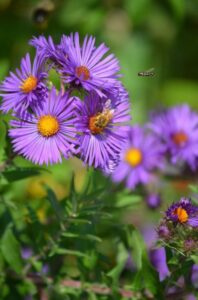
New England Aster photo courtesy of Let’s Plant
How to germinate
Most wild plant seeds have built-in dormancy mechanisms that prevent the seed from germinating. To grow these plants anywhere, you must first break this dormancy mechanism, which will allow the seed to grow. This species has specific germination instructions. It has a germination code of C(60), which means you have to artificially stratify the seeds for 60 days, or sow seeds outdoors in the fall to over-winter naturally to see germination the following spring. Please review the online germination code handbook for more information.
How to plant
Once stratification is complete, sow the seeds outdoors into rows, ⅝ inches deep into the soil. Ensure the seeds are spaced 30 cm apart.
- This plant needs full or partial sun exposure, and wet, medium-wet, medium, or medium-dry soil conditions to grow.
- Can it be chelsea chopped? Yes
- Can it be aggressive? No
Characteristics
- Life cycle: Perennial
- Height: At least 5–6 feet (150–180 cm)
- Spread: 2 to 3 feet wide (60–90 cm)
- Bloom time: August–October
- Bloom colour: Purple, pink
- Stratification: Yes
